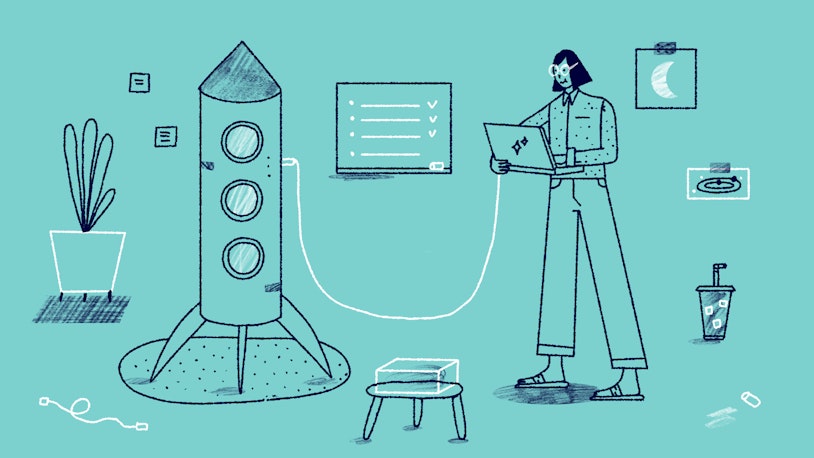Over the last decade, cultural trends, customer expectations, and business realities have combined to compel more and more businesses to prioritize customer success. Companies understand that, for customers to continue growing their lifetime value, they first need to feel successful with the product.
However, a lot of confusion has sprung up around how to ensure customers are successful: Are there specific metrics one needs to follow? Is there a playbook that companies can adopt to ensure success? Similarly, is customer success any different from other functions, such as customer support?
Below, we share an overview of everything you need to know about customer success.
What is customer success?
Customer success is the effort a business undertakes to help its customers be most successful, both with its product and in their own business operations.
However, it is no longer sufficient to assume that the company as a whole will take on customer success management; for your customers to shine, you'll need someone (or a team) to be wholly focused on it. Dedicated customer success teams take a proactive, data-led approach to helping customers more effectively use a product.
Depending on the structure and maturity of the team, it may handle everything from trial user engagement through renewal. This comprehensive approach helps businesses reach several top-level goals, including:
Increasing renewal sales and revenue.
Inspiring customer loyalty and retention.
Boosting lifetime customer value and annual recurring revenue (ARR).
Reducing churn.
Customer success increases the likelihood that users will stick around by maximizing their mastery of the product. For subscription-based businesses, that's a vital component of growing monthly recurring revenue (MRR). For companies that don't follow that particular model, the value of customer success shows itself with leading product insights and word-of-mouth marketing.
However, customer success experiences overlap with other customer-facing functions, such as customer support, customer experience, and even account management. As easy as it is to talk about what customer success is, it's equally important to distinguish what it isn't.
Customer success vs. customer support
Many customer success teams report through the same structure as support or service and exhibit the same customer focus, but there is at least one key difference.
Customer service and support are primarily reactive, meaning they respond to a customer or user after an issue has occurred. Customer success is proactive in that they try to anticipate and address needs before customers ever reach out.
Here's an example Ryan Engley, VP of Customer Success for Unbounce, shared that exemplifies the difference between customer success and customer support in practice:
"A customer may email the support team about their landing pages and say, 'Hey, I need help implementing a sticky navigation bar. How do I do that?' They'll jump in and help them figure out the code to set up. A conversation with the customer success team, on the other hand, might start with, 'Why is that something that you think you need? Let's talk about your bigger strategy.'"
Another key difference is the metrics that customer support and customer success use to determine success. Customer support uses metrics like:
Time to response
Customer satisfaction
Handle time
First response resolution
Customer success teams typically take a different approach and use metrics like:
Expansion rate
Churn rate
Average MRR
Customer health
While there may be some overlap between teams, customer service is primarily focused on metrics at an email level, whereas customer success works at a relationship or lifecycle level.
Customer success vs. account management
Like customer support and customer service, account management (AM) teams offer reactive help to customers who reach out and ask for it.
They handle customer problems after they arise — and do so for a particular set of dedicated customers. Typically these are higher value accounts or accounts that have the potential to grow and expand meaningfully within the foreseeable future.
While both account managers and customer success teams focus on the customers' overall health, AMs do so through the lens of money. As their title implies, they manage accounts by growing them and bringing in revenue to the business.
While some customer success teams may emphasize revenue and MRR, it's not usually their whole focus.
Customer success vs. customer experience
Customer experience (CX) is another function that's grown over the last decade, and it's easy to confuse with customer success.
The chief difference is that customer experience teams focus more on how customers use a product and view it from the business perspective. To do this, customer experience teams may do the following:
User testing
A/B product testing
Customer interviews
Product and licensing surveys
Aggregate insights from customer-facing teams
While customer success can offer profound insights and influence most of these activities, they are not responsible for aggregating feedback from any data point besides directly from the customer. They also are not ultimately responsible for deciding what to do with those insights, outside of interpreting how they may use them to make customers more successful.
Success teams seek to understand why customers use a product, and they use data (aggregated and interpreted by the customer experience team) to proactively help customers be more successful.
Why is customer success critical?
One of the most significant driving factors in the rise of customer success is the growth of SaaS and subscription-based business models.
Instead of selling big, one-time deals to customers, more and more companies are moving to a subscription model. In that model, products need to prove their value before every contract renewal. Renewal hinges on helping customers continually see value and success with the product, since there's almost always another competitor or version of the product that customers could choose.
However, customer success is universally beneficial for every company, even without the renewal and contract cycle. Data shows that for every one customer who contacts customer support, 26 customers with a problem don't reach out. Those are all customers a business stands to lose if it doesn't fix its problems, as research also shows that 91% of those who don't complain simply churn instead.
By proactively eliminating potential customer problems and recognizing customer needs, customer success gives your business a better chance at retaining those other 26 customers.
When done effectively, customer success can reduce churn, improve retention and renewals, and drive revenue. Beyond those substantial fiscal bonuses, customer success also gives your company essential insights into how and why people use your product.
Customer success drives intimate customer knowledge, which ultimately creates a healthier, more risk-resistant customer lifecycle.
Key responsibilities of a customer success team and manager
We've talked a lot about the fantastic value that customer success adds to a company but not the functions through which it does so. Here are a few essential functions that almost every customer success team is responsible for.
Onboarding
Some companies choose to focus on a one-to-many onboarding strategy using email campaigns, in-app onboarding, or a webinar series. Other companies may prefer a more hands-on approach and schedule "kick-off" calls with every new paying customer. They discuss the customer's needs and expectations for the product and build out an implementation plan over an onboarding period.
Depending on the size of your team or your ability to scale, one approach may make more sense for your business than the other. For instance, if you are a small team that is growing quickly, you may not be able to hire enough people to talk to every single new customer.
Whatever approach you take, onboarding is a crucial function of your customer success team. Ensure that, right when the customer starts paying, your team guides them on best practices and which parts of the product will be most beneficial to them in which order.
Assisting in renewals
As we noted above, there are vital differences between account management and customer success. In some companies, customer success may be wholly responsible for renewals — handling everything from getting the contract negotiated to signing it.
However, customer success is generally better suited to lending assistance to the renewal rather than managing it entirely. After all, customer success managers are best suited to helping customers find success, not increasing sales or boosting MRR.
Use your customer success team to consult with your renewals or account management teams on which features or upgrades might be helpful for the customer based on their stated goals with the product. Then, use them to add some legitimacy to the renewal process.
Your customer should trust your success team unequivocally, or at least more than they would trust a salesperson they haven't worked with directly for very long. Use the trust and user knowledge your customer success manager has to make the renewal negotiations easy.
Monitoring customer health score and product usage
Your customer success managers are typically at the front line when it comes to your customers' relationships with your product. Unlike support, they build ongoing connections and are constantly hearing what is or isn't working.
Beyond that, your customer success team is often responsible for managing and tracking customer health. The customer health score is typically a proprietary score built off of a combination of product usage, services usage, and login metrics. It is a great leading indicator for the customer's likelihood to renew and can also, at a larger scale, show your company the most and least used areas of your product.
Your customer success team will be able to see right away if usage of a specific feature drops off. If they don't hear that directly from the customers, they will see it within the customer health score dashboards.
From there, they may inform product and engineering, connect with your support team, or even reach out directly to the customer. This is a great way to ensure that everyone is abreast of the latest product usage and that no pesky bug goes unnoticed.
Providing customer insights to engineering and product teams
If a customer is dissatisfied, the first person that they'll probably tell is their customer success manager (CSM). CSMs work hand in hand with your engineering and product organizations. Any time a road map changes or a new feature is about to hit your live product, CSMs need to be kept in the loop.
In exchange, your customer success team can often provide an excellent barometer for how useful a customer will find a new update.
When your product and engineering teams are planning for the next few quarters, it's up to your customer success managers to successfully surface the most pressing needs expressed by their customers.
CSMs are the best at interpreting customer requests and packaging them in a way that’s understandable and helpful for your company.
Positioning best practices
While other teams may be more advanced in the technical aspects of your product, your customer success team should be the best at positioning how to make the most out of your product.
What this means is, even if they can't necessarily answer the best API method to use to take a specific action in your product interface, a good CSM will be able to listen to what a customer is trying to accomplish as an end goal and determine if an API method is the best way to get there.
All of your other teams can answer the "how to do it" questions, but your customer success team is there to help your customers understand the "why" behind them.
Connecting the customer with necessary teams
Even though CSMs may not always be the folks equipped to answer the most technical questions, they certainly know where to find the people who are. Your CSM should serve as an operator helping to connect the calls from your customers to other parts of your company.
It's nonsensical to think that a single person could fill out the role of professional services, your product team, and your support reps — especially if they are also helping to map out your customers’ usage and ideal product setup.
Rather than answering every question, CSMs should know who the best person is to answer those questions.
Say, for example, a customer reaches out about how to custom-build something using a more technical part of your product. It likely doesn’t make sense for your CSM to answer that question. Instead, the CSM would connect the customer with the person most skilled at that type of custom work, like someone from your professional services team.
You best serve your customers with a CSM who knows your company's available resources and how to connect them with the customer in the quickest way possible.
Maintaining communication
If your customer can't remember the last time they heard from your success team, your CSMs aren't doing their jobs.
It's up to your CSMs to set expectations and maintain an ongoing cadence of communication with any customers within their book of business. That cadence doesn't need to be the same for every customer and will often differ in frequency depending on where the customer is in their life cycle and their current goals.
However, there should still be a regular and expected sequence of communication. Each time a CSM ends a meeting with a customer, they should have fully communicated the next steps and when the customer can expect to meet or talk again.
This is how your CSMs can ensure that they have a thumb on the pulse of your customers’ needs and goals and can quickly prevent any churn or issues with product usage.
7 tips for enabling customer success
Regardless of the size or scope of your company, there are a handful of things you can do to help your customers succeed — with or without a dedicated customer success team.
1. Make customer success an organization-wide goal and priority
Whether you have a dedicated customer success team or not, it's essential to emphasize helping customers succeed across the organization. From sales and marketing to product and from senior leadership on down, customer success should be a goal and a priority for every member of your extended team.
One of the best ways to ensure that customer success is a priority is by educating your company on what customer success does and where its value is. Different teams will interpret data differently, so to ensure that you are conveying your message in the most viable way, speak the language of the team you're talking to.
Product, for instance, may care about customer health score and ongoing expansion of product usage, while sales may care about the number of customers you are retaining and how much they are worth. Pick the metrics you use based on who you are talking to.
2. Emphasize customer success early on
Customer success is an organization-wide effort, meaning prioritization of customers and their needs has to be baked into your company's culture. The easiest way to make that happen is to start early, from the very outset of your business.
For instance, you can encourage everyone in the company to sit in on kick-off calls or have your engineering and product teams conduct conversations with customers about new/beta products that they might be interested in.
Having these individuals on calls helps give them a better experience and cultivate a culture of customer success. It also helps the customer feel important and valuable. Your efforts don't need to be huge to be meaningful. Even an additional meeting with a member from a team who customers typically assume as "busy" can go a long way.
As the saying goes, the best time to start was yesterday — the second-best time is now.
3. Understand what success means to your customers
We've talked a lot about "success," but what does it mean? Effective teams let the customers tell them what success looks like. Success with your product will look like different things to different customers, so it's essential to let their definitions lead.
Many companies assume that the actions they want their customers to take are those they should base metrics on. Often, this is without any foundation in reality.
To best understand what success means to your customers, it's important to have ears on the ground, listening to and studying what the customers are doing within the product. This is one of the critical roles of your CSMs.
Your company should be shooting to grow success as defined by the customer, not success as you assume or expect it to be.
4. Set customers up for success with proactive onboarding
The role of customer success starts from the moment someone becomes a customer.
Proactive customer onboarding ensures those new customers get started on the right foot. That includes setting up the product to best suit their needs, learning how to use the features they need, and getting comfortable with using the product more generally.
While a little extra hand-holding during the onboarding process can make a huge difference, it may not be practical for every company to offer high-touch customer success from the start. Instead, focus on how to get every new user and customer the same information in a consumable way.
If you don't currently have the staff to offer that to every person using your product, try to figure out ways to tier it out. Perhaps that means offering in-app, checklist-style onboarding for free trial users and full, video kick-off calls for paying customers.
One of the most common ways to tier customer success is based on the amount of money that customers are paying. It makes sense that paying customers would get a more personalized experience than those using your free trial.
5. Track key customer metrics and share data across teams
As we mentioned above, customer success is highly data-driven. The metrics used within customer success can be very influential cross-functionally among teams.
Effectively prioritizing and sponsoring customers' success includes tracking the right customer metrics and sharing that data across teams. Here are a few key customer success metrics worth monitoring:
Customer lifetime value
Repeat purchase rate
Customer retention rate
Customer retention cost
Churn rate
Customer health score
6. Build a customer feedback loop
Customer success isn't a one-time project that carries over from one customer to the next. It's an endeavor that requires constant updating and refining to serve customers better and keep up with a changing product.
Even a great strategy may need to be slightly tweaked for two customers from different industries or with different expectations.
After each conversation with your customers, ask them for insights on how your team is doing. That could mean the product itself, the experience your company offers, or even the direct relationship with the CSM.
Regularly asking and keeping a door open will ensure that, if something does go awry or starts feeling bad, they'll feel comfortable telling you. You should constantly be iterating and refining your strategy based on customer insights and feedback.
Creating a loop that continuously brings in honest customer feedback is the best way to keep up with those changes and ensure you can remain proactive for the long term.
7. Define and identify red flags
When you look into your customer data, there are typically early warning signs indicating that a customer is struggling with your product. The customer success team's job is to identify these red flags and find a way to proactively set struggling customers back on the path to success.
One of the best ways to do this is to use tagging within your help desk or, if advanced enough in your customer success strategy, sentiment analysis to automatically predict and notify team members of the potential issue. The sooner you can start identifying leading indicators and act on them, the better an experience you will provide.
Once you have a system to notify your customer success managers effectively, they will be more empowered to work directly with your customers to rectify any issues or provide needed education and help.
Help your customers succeed
With the rise of subscription-based business models and a broader cultural emphasis on putting customers first, every company in business today can benefit from implementing a customer success program.
It's an excellent way to boost your customers' experiences with your product, offer critical insights back to your internal teams, and even streamline existing processes or features to make them more efficient.
Be it large or small, a customer success team can have a significant impact on customer loyalty, churn, revenue, and so much more.















